Introducing the Revolutionary Armin Strom Mirrored Force Resonance – and why it is a such Breakthrough in Watchmaking (VIDEO)
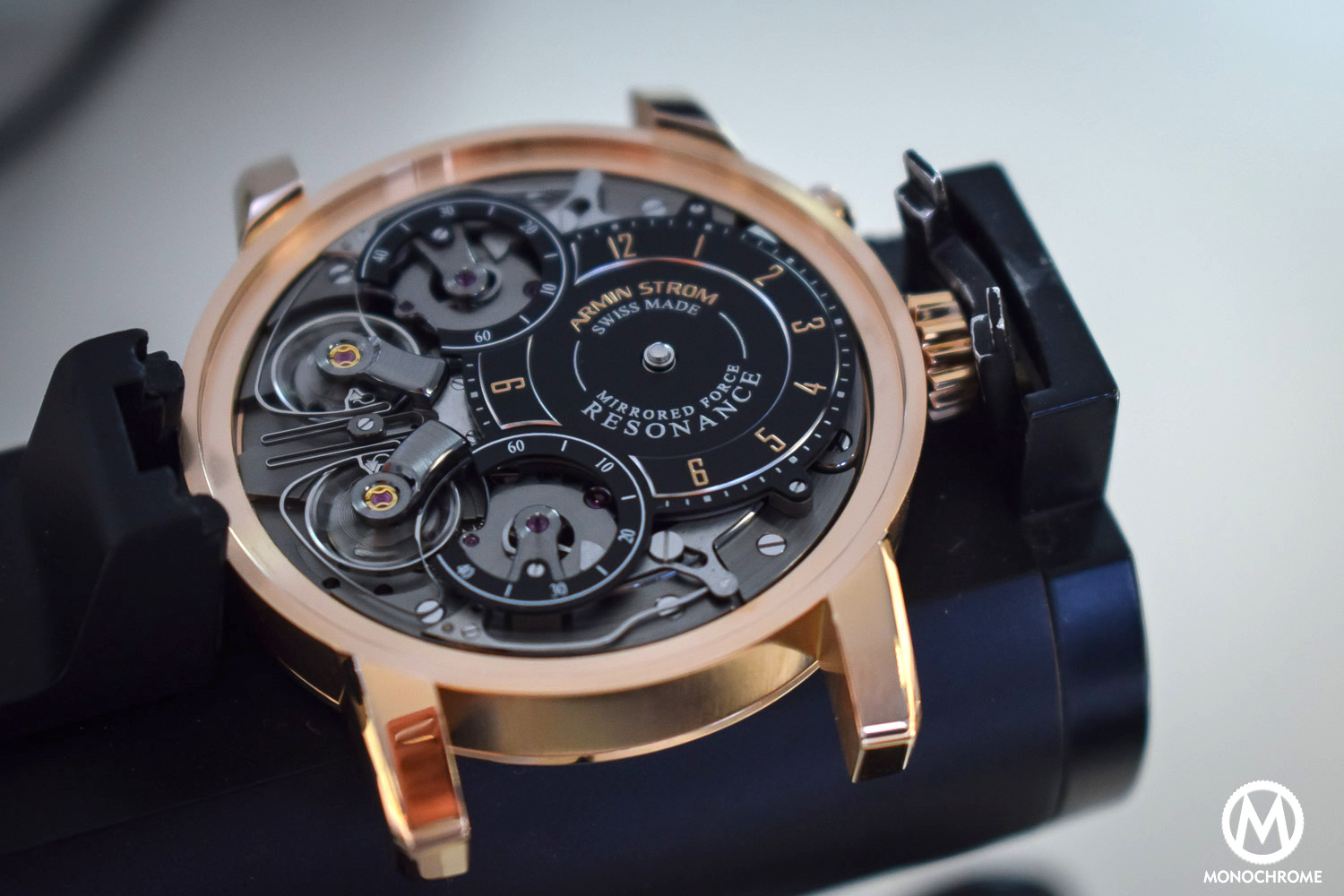
A breakthrough in Watchmaking: introducing the Armin Strom Mirrored Force Resonance. Until now, Armin Strom was known for its superb skeletonized watches, mixing haute horlogerie features and sporty design. Today, Armin Strom propels a century old concept, Resonance, well and truly into the 21st century. In an exclusive first look, Monochrome unveils this revolutionary development (yes, simply that…) with technical insights, video and pictures.
What is Resonance
Resonance is one of the most unexpected and striking phenomenon in all physics. Through resonance, a comparatively weak vibration in one object can cause a strong vibration in another; two oscillating bodies in close proximity influence each other and eventually synchronize…
Resonance is easy to observe. Pushing a person on a swing is a common example. Electrical resonance allows radio frequencies to be selectively received. How can a glass wine break from sound? Every object has a natural frequency at which it prefers to vibrate. The glass breaks because the sound is at its optimum resonating frequency…
Resonance – sent wave causes other tuning fork to vibrate
Back to 1665, the prominent Dutch mathematician, scientist and horologist Christiaan Huygens reports an odd phenomenon. Two of his recently invented pendulum clocks hanging from a common wooden beam were oscillating in perfect consonance. “… It is quite worth noting that when we suspended two clocks so constructed from two hooks imbedded in the same wooden beam, the motions of each pendulum in opposite swings were so much in agreement that they never receded the least bit from each other and the sound of each was always heard simultaneously. Further, if this agreement was disturbed by some interference, it re-established itself in a short time. For a long time I was amazed at this unexpected result, but after a careful examination finally found that the cause of this is due to the motion of the beam, even though this is hardly perceptible.” Without the mathematical tools to demonstrate his observations, Huygens did though in turn manage to explain why his pendulum where showing an odd sympathy…
Beat Haldimann H101 Resonance Classic pendulum clock, a double regulator equipped with two identical independent movements. Once in motion, both pendulums shortly settle in a mode where they swing in opposition.
The phenomenon has fascinated many watchmakers over the years, though resonance has rarely been attempted, let alone mastered. The list of watchmakers to have successfully worked on resonance is extremely short. It includes past masters like Astide Janvier and the great Abraham Louis Breguet. Among modern works, F.P. Journe presented his Chronomètre à Resonance wristwatch that involves two independent movements: two mainsprings, two gear trains and two regulators. One of the balance cocks can be pivoted to finely adjust the distance between the two balance wheels and escapements to incite resonance, each variation in one movement being corrected by the other. Beat Haldimann also worked on the phenomenon of synchronized movements of pendulum1 designing his H101 Resonance Classic Pendulum Clock. More recently, he unveiled his H2 flying resonance, a wristwatch where a central oversized tourbillon cage carries two lever escapements and balance wheels whose hairspring are connected by a coupling spring.
The new Armin Strom Mirrored Force Resonance
Today, Armin Strom introduces their Mirrored Force Resonance, a groundbreaking development propelling resonance to an unprecedented level. Their resonant caliber ARF15 features two oscillators connected by a steel resonance clutch spring, connected to the balance spring studs. To put it in layman’s terms, this spring acts just like Huygens wooden beam optimized with 21st century technology. The two balance wheels get coupled by the tiny vibrations in the spring. This revolutionary, patented mechanism get the two oscillators to synchronize while making their revolutions in opposite direction (just like Huygens’ pendulums). The two balances find a concurrent rhythm in opposite directions so as to continuously average out errors for maximum accuracy.
The AFR15 resonance clutch spring is the strategic component of the AFR15. While most previous developments to take advantage of resonance have been focusing on the adjustment of the distance between the two regulators, the clutch spring bridges directly the two balance wheel studs, enhancing the propagation of vibrations and the synchronization of coupled oscillators. The spring was perfected over two and a half years until the optimal shape was determined with the objective to maximize the vibration propagation in between the two studs along a horizontal plane (9 o’clock – 3 o’clock axis). Crafted in steel, a traditional horological material, this Monobloc spring is manufactured by wire spark erosion with tolerances of 5 microns.
As Armin Strom’s Claude Greisler explains the advantages of resonance are threefold:
- A stabilizing effect on timekeeping (advantageous to accuracy).
- A conservation of energy (think of a professional cyclist riding in the slip stream of another cyclist in a racing situation).
- A reduction of negative effects on timekeeping accuracy due to outside perturbation such as shock to the balance staff, which in turn keeps the rate more stable and increases precision.
The mesmerizing ballet of the two balance wheels oscillating in opposite directions and in perfect sync and is a spectacle to behold. It takes no more than 10 minutes for the two balance wheels to beat into symmetry. In case of a shock, it takes only a few minutes for the two oscillators to become synchronized again. The frequency used, 3.5 Hz, allows the wearer to fully appreciate the resonant regulators in action. In addition, the beat of each balance wheel is displayed with a second hand in perfect harmony with one another.
The ARF15 caliber is fully developed, manufactured and assembled in-house and provides an innovative solution to improve chronometry, a real horological raison d’être. If Armin Strom have been manufacturing in-house calibers since 2009 (Watch our video presenting their manufacture here), this is by far their most complex development and this is indeed impressing.
A rear view of the Armin Strom mirrored force resonance showing the AFR15 caliber with its symmetrical architecture and open worked barrel with their spring coiled around the arbor.
Beyond its complexity, the Armin Strom Mirrored Force Resonance stands out with its resolutely technical design. The symmetrical architecture of the movement on full display dial-side, its modern yet impeccable finishes, plus the intricate shape of the spring are simply breathtaking. The movement is fitted in a 43.40mm 18k gold case. A pusher at 2 o’clock allows to reset (and synchronize) the twin-second hands. An-off centered subsidiary dial indicates hours and minutes at 3 o’clock, sporting gold hands with luminescent material.
Conclusion
Several watches with multiple regulators have been presented over the recent years in particular with differential systems. In our eyes, resonance is an astonishing, conceptually pleasing (and somehow poetic) development to improve chronometry taking advantage of several oscillators. The Armin Strom Mirrored Force Resonance impresses in many respects. It brings a smart, innovative (and great looking) solution to a century-old concept.
Armin Strom has released some stunning watches over the last few years. The brand has worked on boosting and consolidating its watch credibility and expertise with determination. Their latest creation is absolutely fascinating. At 67’000 CHF, it is obviously not for every pocket but seems excellent value for money for such a development from a small, independent manufacture! www.arminstrom.com.
Technical specifications:
- Case: 43.4mm diameter x 13.0mm thick – pink gold – sapphire crystal on the front and on the back with antireflective coating – 50m water resistant
- Movement: AFR15 with manual winding – 48h power reserve – 25,200 vibrations/h – hours, minutes, twin seconds, two independent resonant regulators. 16’’’ ½ lines x 7.70mm. 226 parts.
- Strap: horn-back alligator strap on pin buckle
- Price: 67’000 CHF
1 Among recent double pendulum clocks, mention shall be made of David Walter, Buchanan clocks, Stephan Gagneux, Claude Schauerte and Florian Frisch.

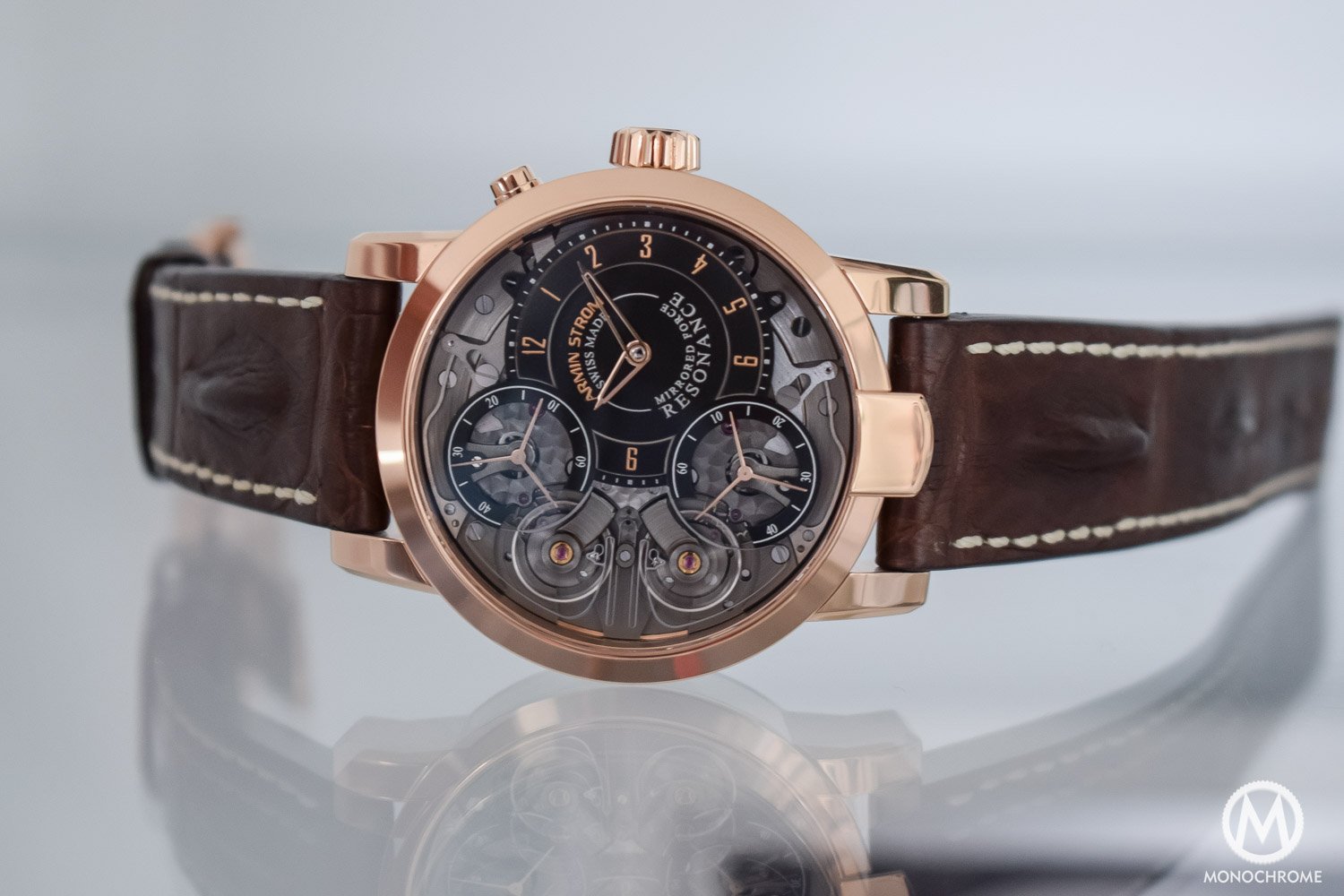
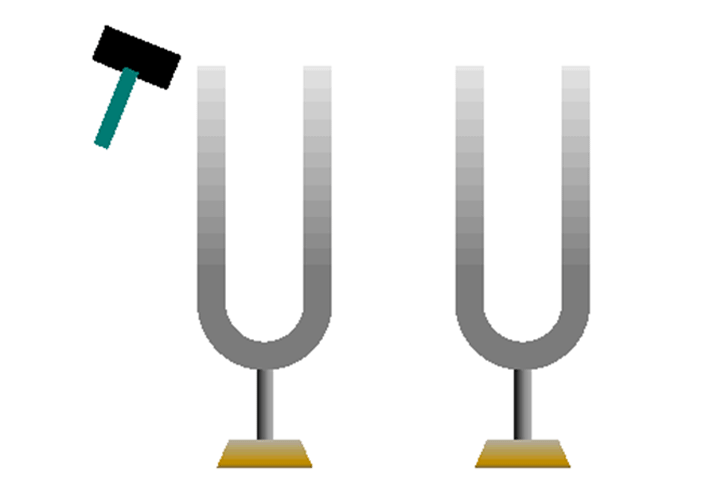

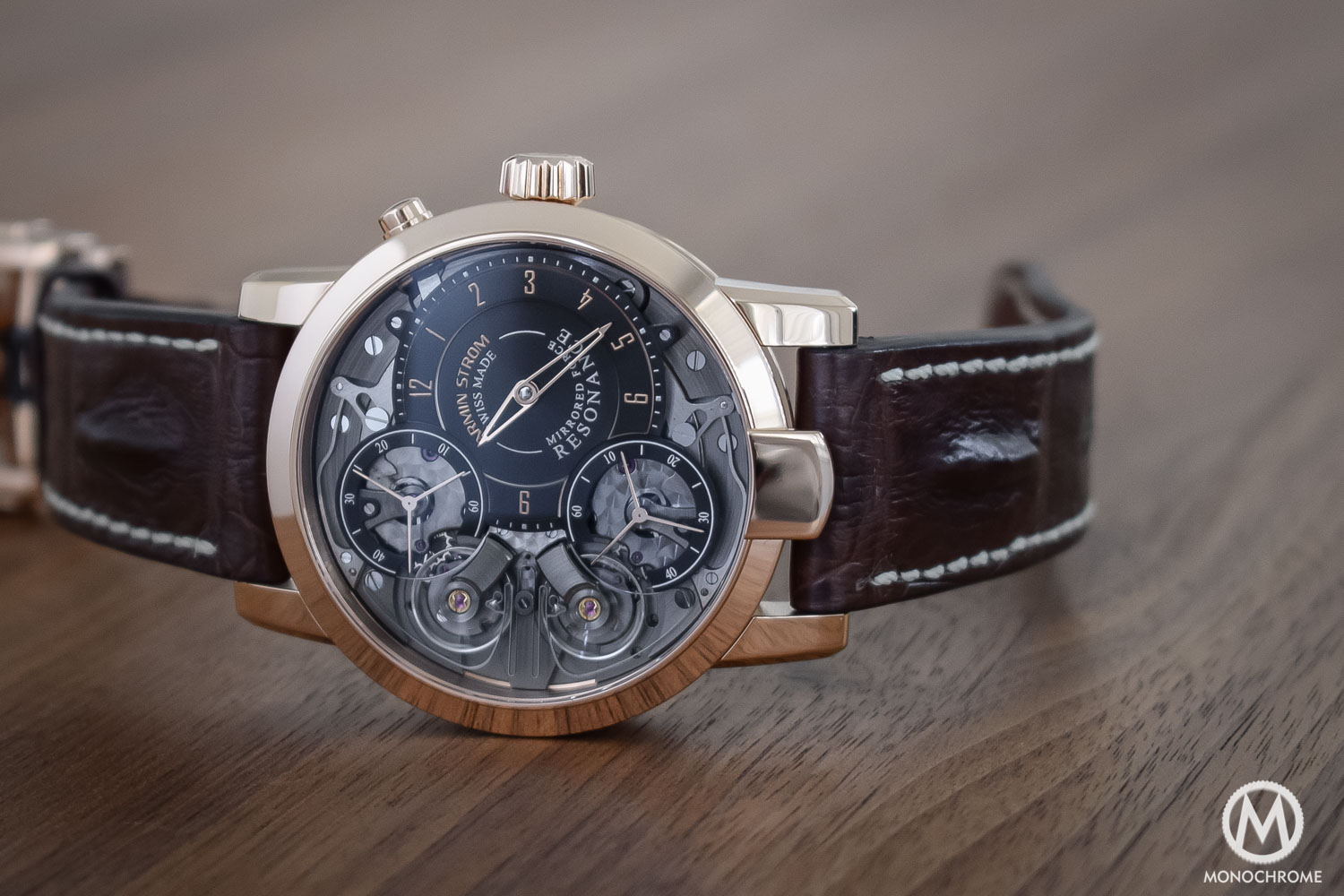
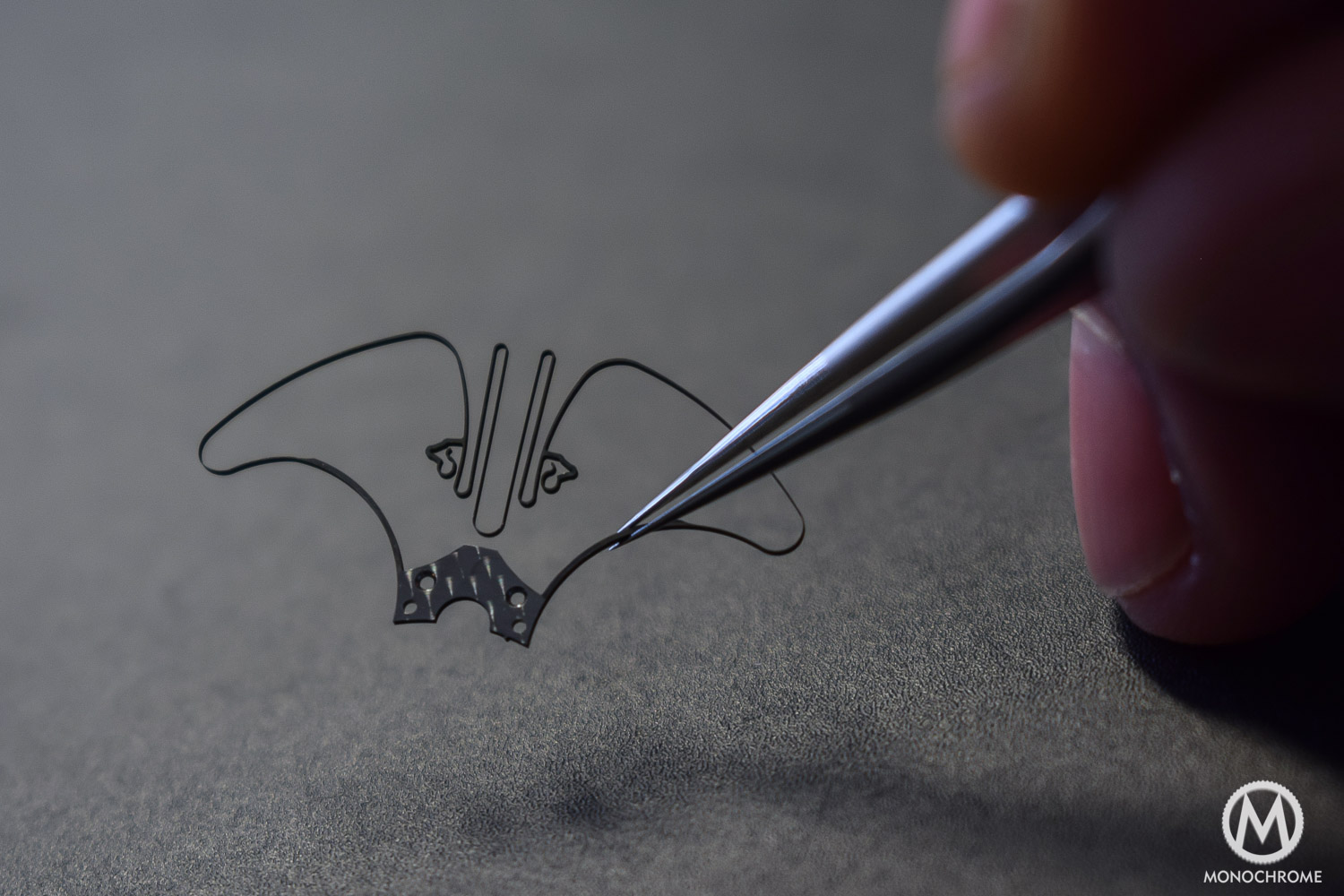

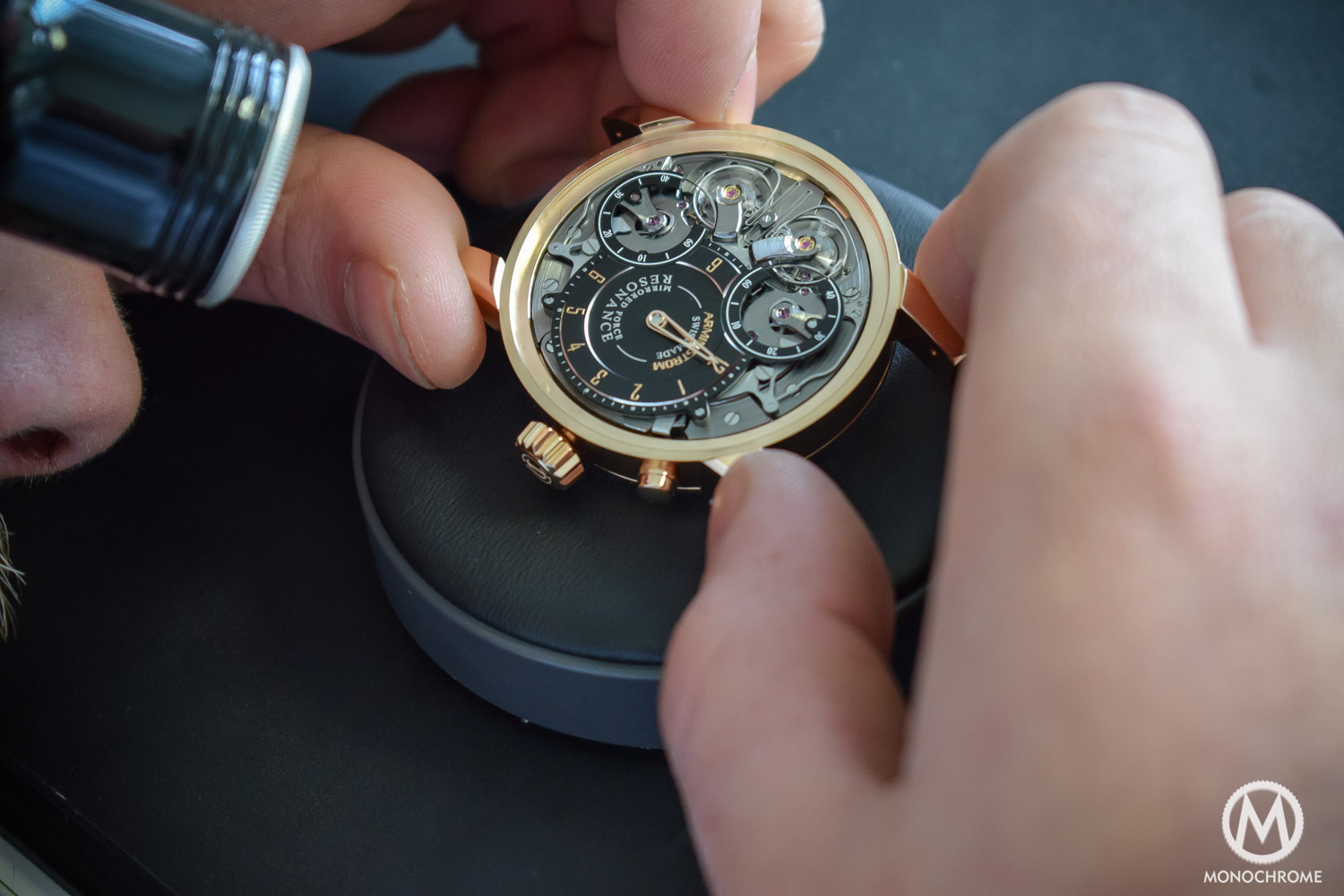
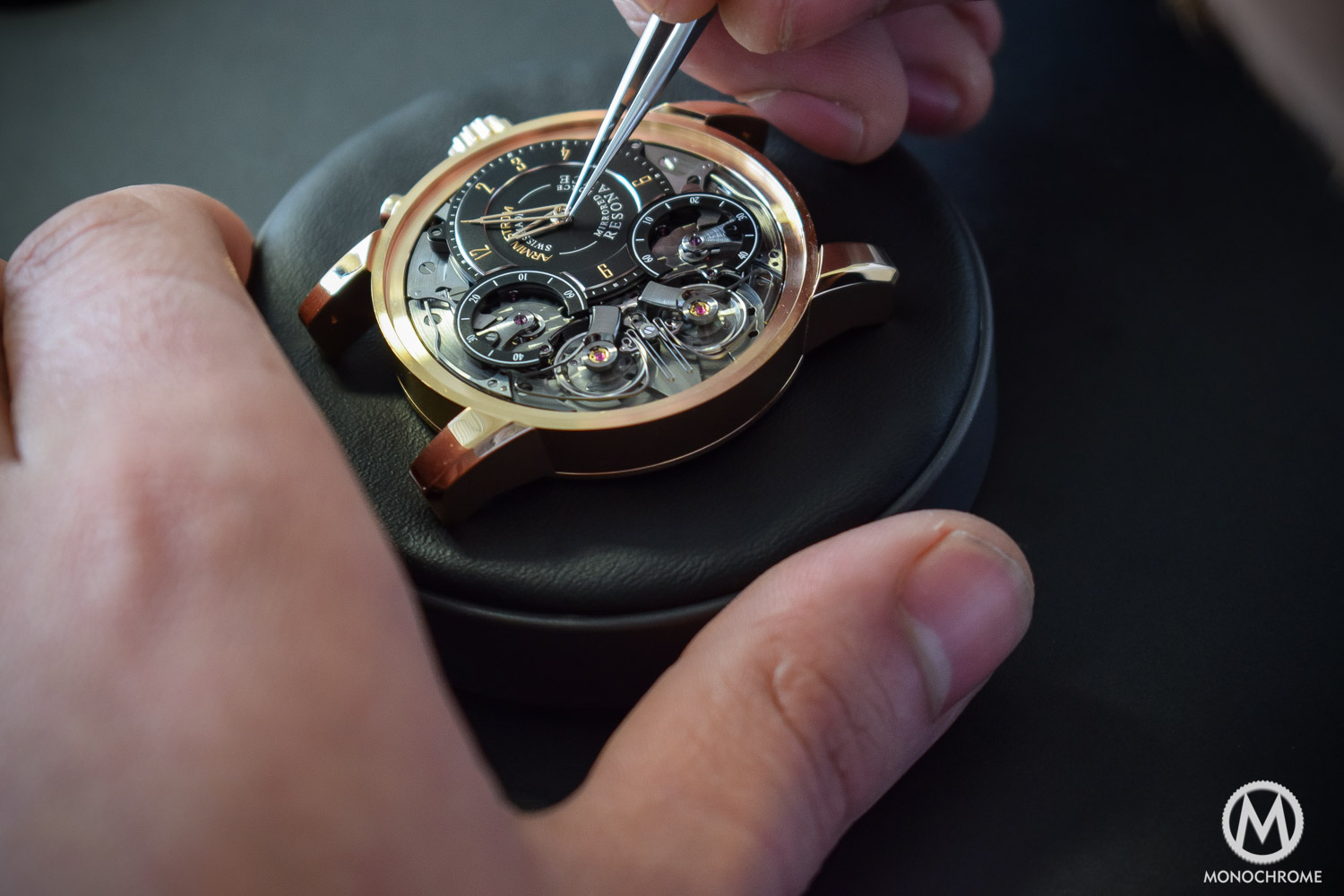
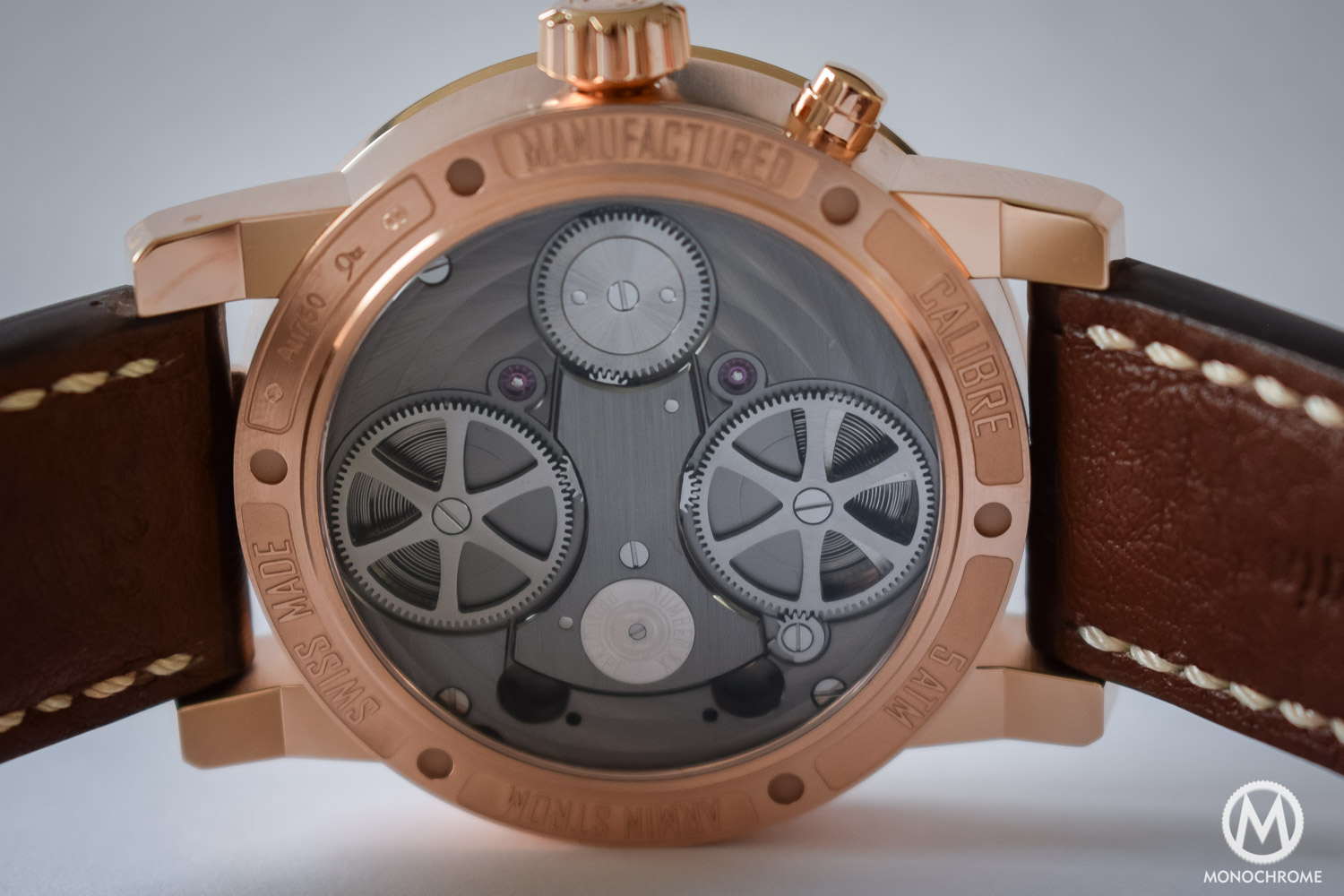
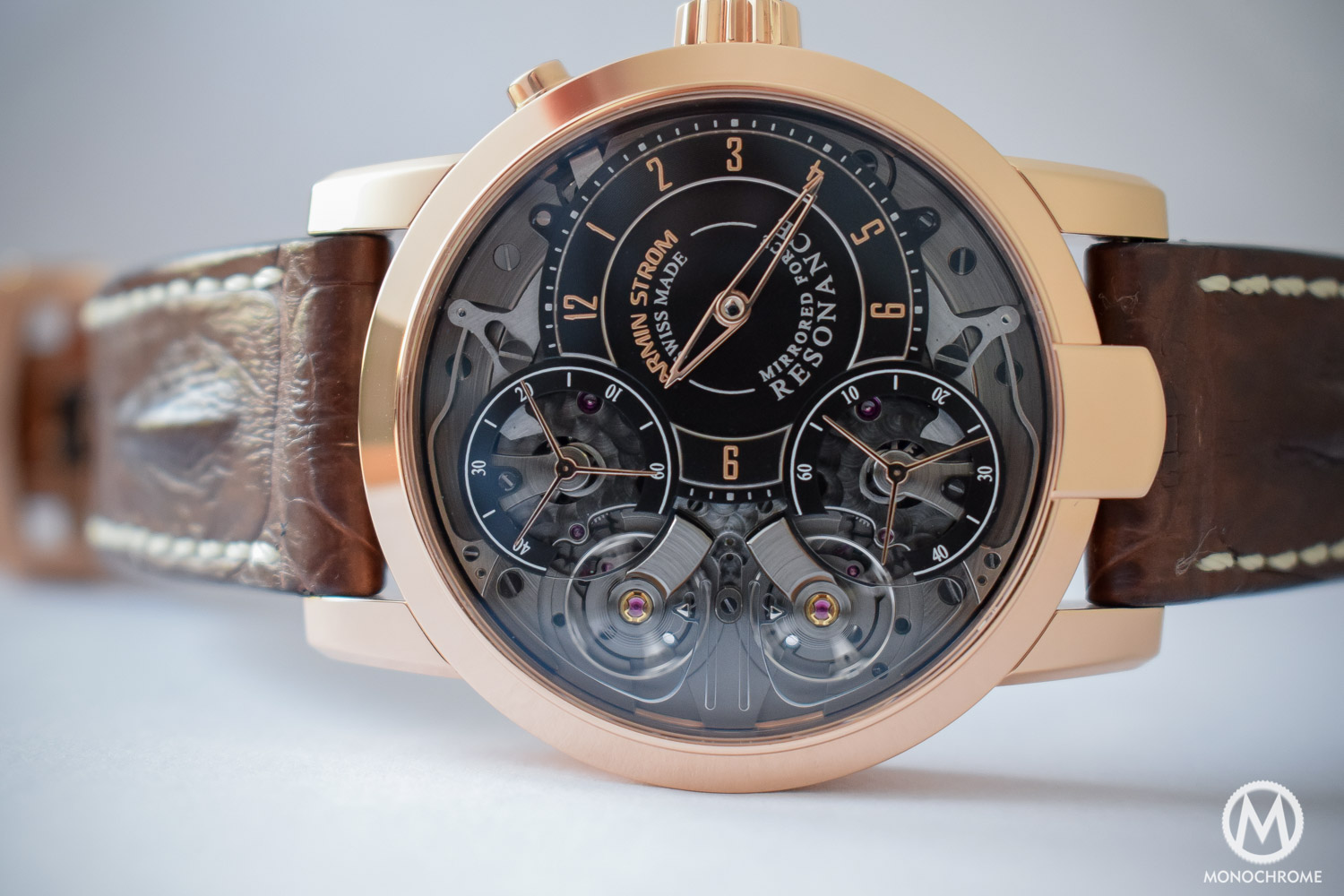
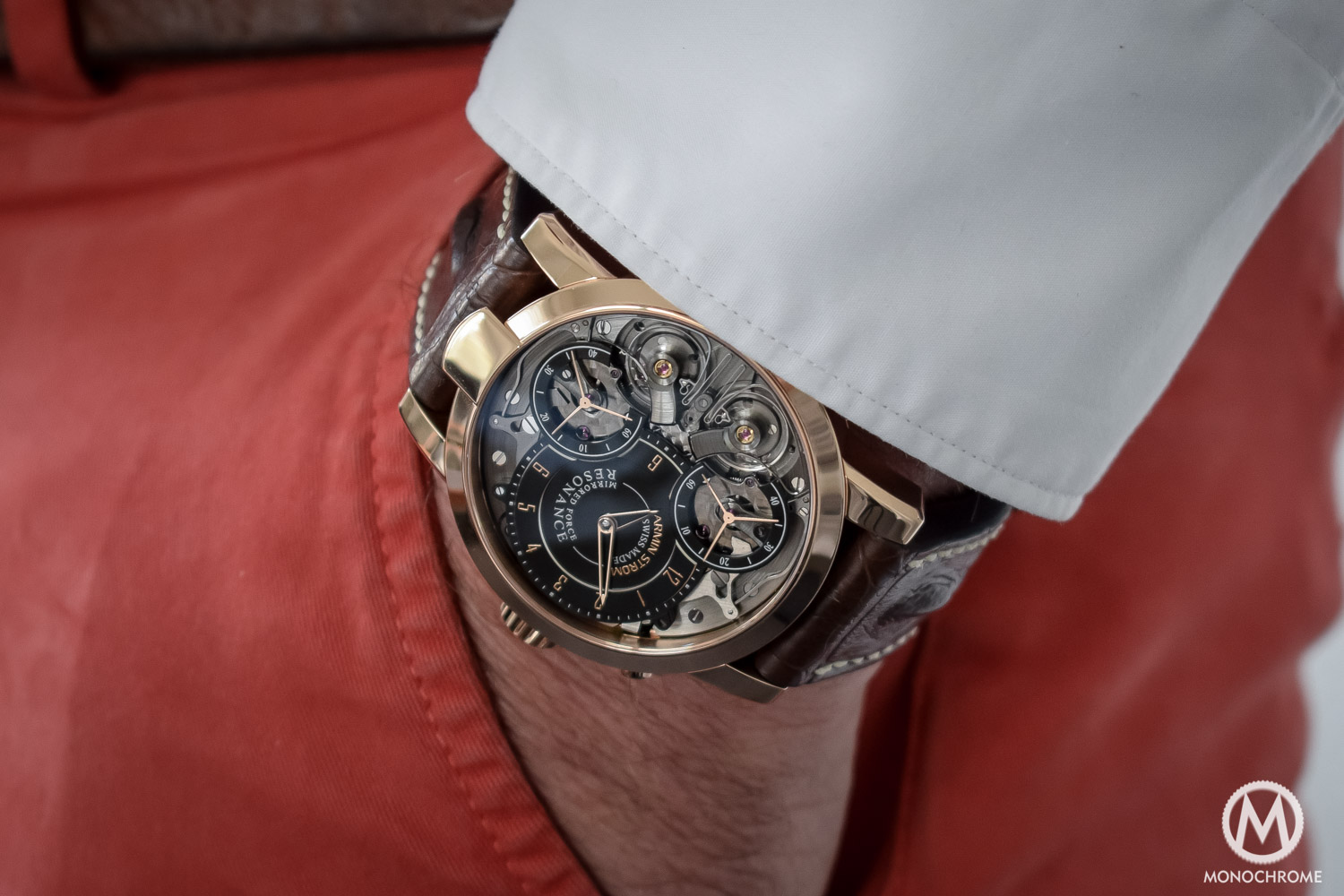
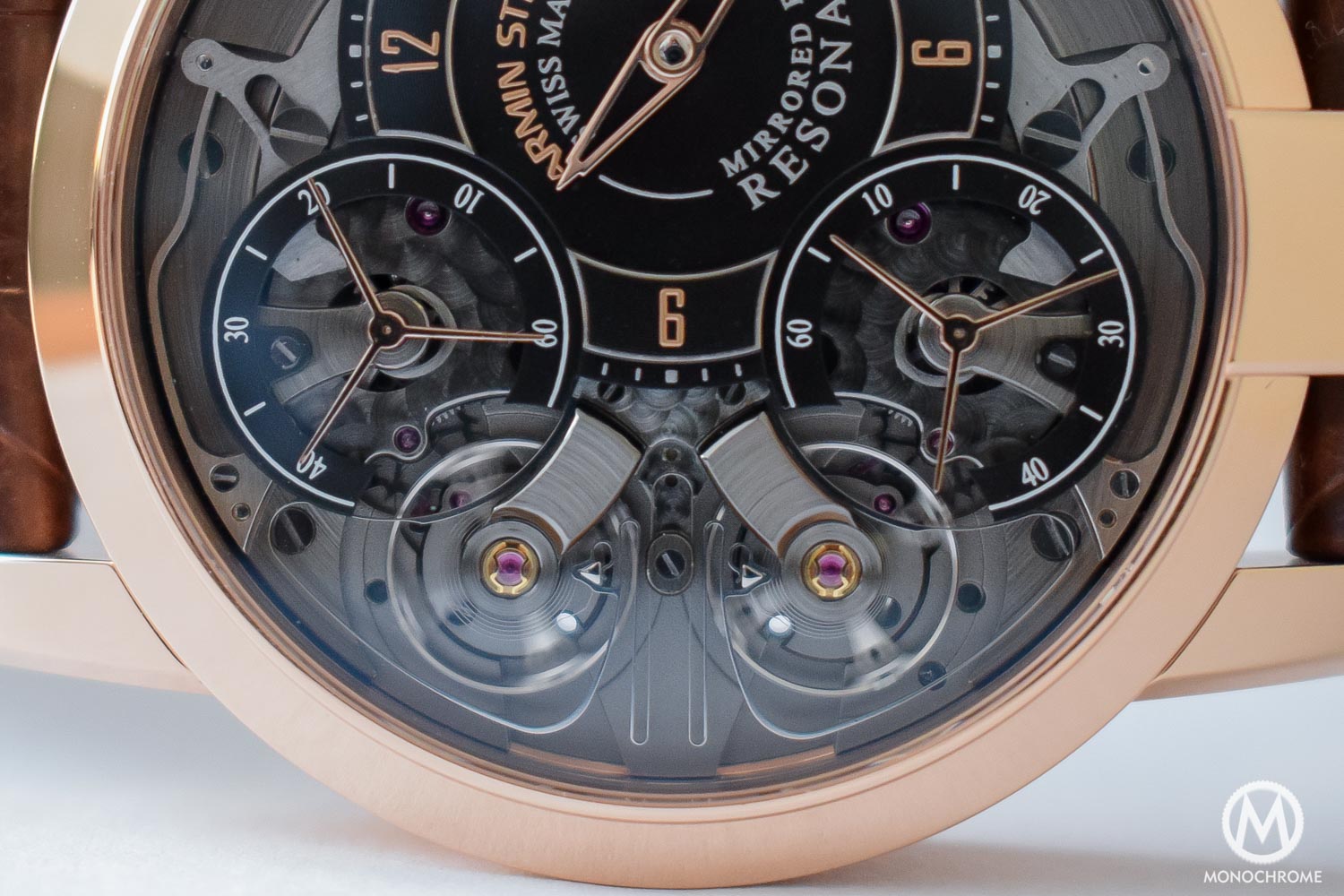
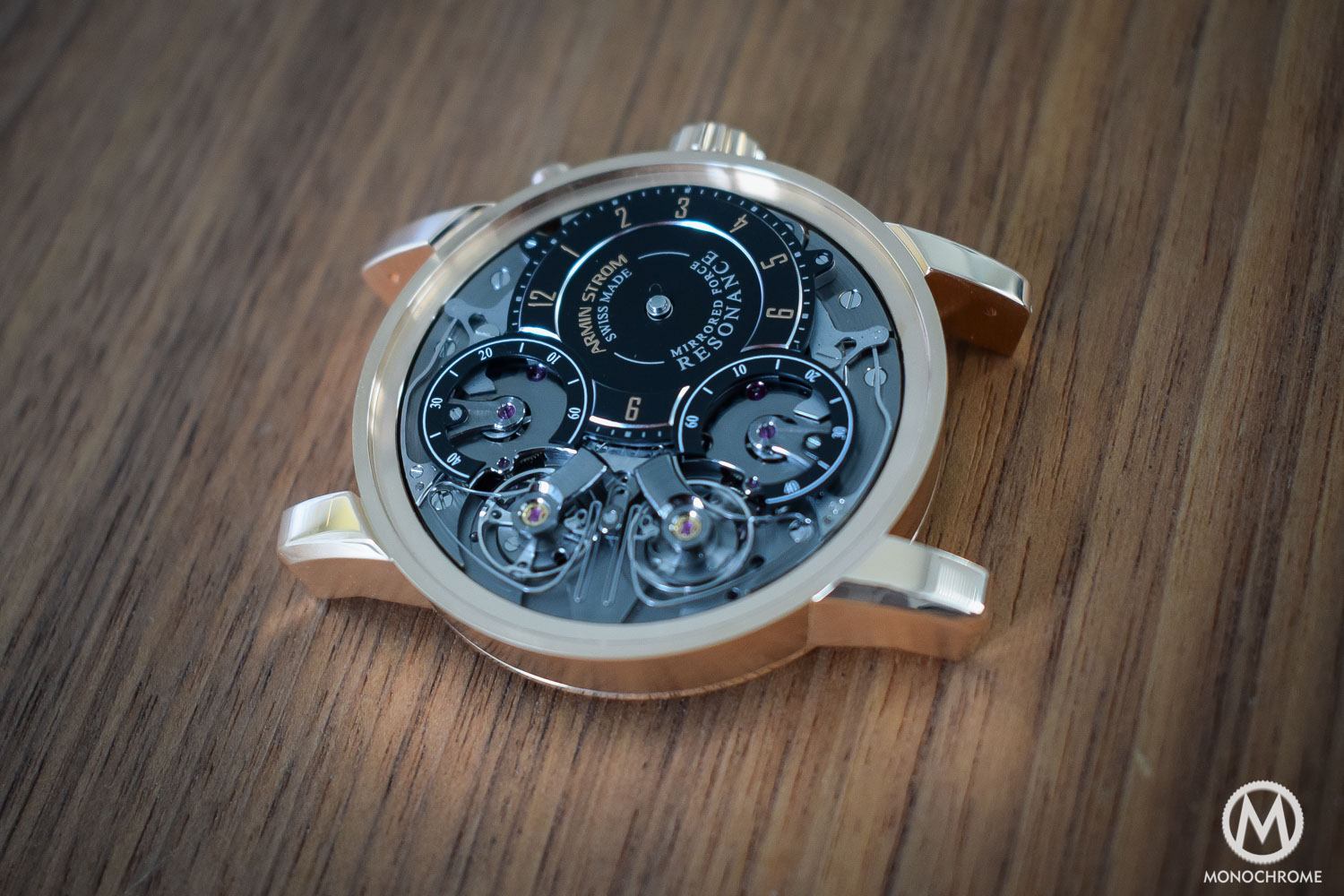



8 responses
With all the talk about synchronous seconds, not one photo shows them at exactly the same position on the dial. It’s like marketing the exception instead of demonstrating the rule. No doubt, however, that this is an outstanding accomplishment. A time trial test or lab results would have been nice. Joe Conway
The pusher allows to put the hand in the same position. Watching them beating in sync then is indeed fascinating. And yes time trial would be indeed worth following. Interestingly the standard witschi devices are inoperant with this watch as the beat noise of the 2 regulators is totally different from that of standard watches. Armin Storm has developed a specific tooling with optical measurement to test their watches…
Hi Xavier, thanks for introducing this really unusual watch.
I’ve always doubted about real effects of resonance in a wristwatch – despite many masters approached it – but never doubt about resonace as a phenomenon (being a musician it often happens that my guitar start to resonate alone influenced by external sounds).
It would be extremely interesting to check technical measurement and the way they’re executed.
Regards,
slide68
Hi Andrea, Thanks. Just like you I have been wondering about how operant resonance was in the context of a wristwatch. Although I am convinced of the phenomenon and the fact that indeed oscillators beat in sync, how quick and how effectively it happens, how stable it is, what parameters influence it have always intrigued me… still I believe the Armin Strom solution brings something unprecedented and rather convincing. Spending half a day with Claude Greisler and their watchmakers was indeed an experience…
A fasinating accomplishment, Armin Strom”s peculiar case design (the protuberance on the bottom of the case) detracts from the otherwise involving design. The use of an iron spring to accompish the resonace is troubling in that any strong magnetic force could alter the resonace effect.
All this talk about accuracy! So just how accurate is this movement? Will it match the +/- 2 sec/day advertised by Rolex, or is it just a pretty but unnecessary complication? Surely the manufacturer has the data… numbers please!
Dear Ed, While it is difficult to compare the results obtained by Rolex on thousands of watches produced every year and the first batch of prototypes tested by Armin Strom (the statistic sample size being so different), the solution they have developed seems rather promising. The brand traditionally regulates its movements with COSC-like tolerances and estimates that the resonance phenomenon on their new development allows to improve the daily rate variation (measured in 5 positions) by 30%.
Dear Shirley, Indeed steel parts have the disadvantage that they might be affected by magnetism. The advantage is that as a traditional horological material it will still be potentially repaired in decades. Still it will be interesting to see if Armin Strom uses different materials for the spring in the future.